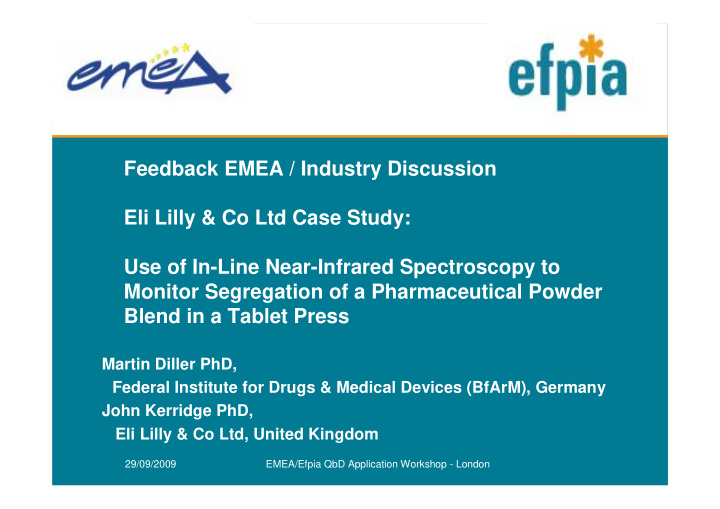



Feedback EMEA / Industry Discussion Eli Lilly & Co Ltd Case Study: Use of In-Line Near-Infrared Spectroscopy to Monitor Segregation of a Pharmaceutical Powder Blend in a Tablet Press Martin Diller PhD, Federal Institute for Drugs & Medical Devices (BfArM), Germany John Kerridge PhD, Eli Lilly & Co Ltd, United Kingdom 29/09/2009 EMEA/Efpia QbD Application Workshop - London
Case Study Summary • Real time powder uniformity monitoring during compression • Non-contact NIR probe NIR probe positioned in Fill-o-matic Feeder Frame, prior to tablet compression. ~ 10 – 15 mm from tablet die. • Technique allows for :- – rapid & non-destructive content uniformity assessment – segregation determination of the blended materials, both API and excipients, going directly into the final pharmaceutical solid dosage form, i.e. tablet. 2 29/09/2009 EMEA/Efpia QbD Application Workshop - London
Case Study Summary – NIR System - Rapid data acquisition times (<35 milliseconds per spectrum) – Shown to provide an alternate strategy for demonstrating adequacy of mixing of powder blends – Excellent potential to monitor a larger fraction of the entire blended sample preparation – Improved statistical description of variation within an entire production batch. – Improvement on PQRI Draft Guidance recommendation – of using stratified sampling of both the blend and dosage units at specifically targeted locations 3 29/09/2009 EMEA/Efpia QbD Application Workshop - London
Case Study Summary % Drug Content Layered in chute Layered powder 5.5% fractions of differing 4.5% concentration in tablet hopper 4.0% 4.5% 7 6 N I R E stim ate H PL C M easur em ent 5 Concentration, % 4 3 NIR 2 Accurate product monitoring in Data real-time throughout the batch 1 0 50 100 150 200 Elasped Tim e, m inutes 4 4 29/09/2009 29/09/2009 EMEA/Efpia QbD Application Workshop - London EMEA/Efpia QbD Application Workshop - London
Case Study Summary • Conclusion – In-line NIR method provides for an additional tool in the QbD/PAT tool box – Can be used to assess and identify critical sources of process and product variability • Eg correlating properties such as particle size, shape, density, surface texture, cohesiveness, etc. to powder flow and uniformity – Enables production of a more consistent product that meets predefined critical quality attributes. – With development may provide an opportunity for alternative product testing strategies 5 29/09/2009 EMEA/Efpia QbD Application Workshop - London
Main Topics Discussed • Technical questions • Introduction of novel technologies – Data required in submissions – When does “novel” become “platform” • Development – improving Process / Product Knowledge – Traditional versus “monitoring” sampling techniques – Data presentation for assessment (quantity/section) – Bridging studies between traditional and novel techniques – Pure process knowledge information – does it need to be presented for review 6 29/09/2009 EMEA/Efpia QbD Application Workshop - London
Main Topics Discussed • Design space / Control strategy – Data for process understanding / development purposes – Potential use as “real time release test” • Regulatory Framework – Current regulatory framework changes needed to enable implementation – Provision of timely advice on new CMC approaches 7 29/09/2009 EMEA/Efpia QbD Application Workshop - London
Common Understanding • NIR spectroscopy is a potential and suitable tool for controlling process and product quality • NIR could replace existing IPC • NIR could add to existing IPC to povide enhanced information on manufacturing process • NIR measurement provides increased knowledge of process variability • Increased sampling frequency (continuous verification) • Does this provide a basis for changing conventional thinking and decision making ? • EMEA NIR guidance is currently under review 8 29/09/2009 EMEA/Efpia QbD Application Workshop - London
Common Understanding • Concept development – Potential for technique to replace end-product-testing (real time release testing) – Thorough risk assessment and evaluation needed – Understand key parameters • Eg impact of machine type, influence of excipients • Dossier submissions for new technologies – Explain concepts, science and summarise key data – Supporting information eg spectra would be reviewed at inspection • A PAT defined control strategy would need to be fully integrated into a Quality Management System – Eg . Atypical results, Out of specification process – Strategy may be specific to technology / technique 9 29/09/2009 EMEA/Efpia QbD Application Workshop - London
Areas for further work • Defined structures for training and advice are necessary (industry and regulators) • e.g. workshops, presentation s on new PAT approaches • Take opportunities for using EMEA PAT team and Scientific Advice procedures • accurate definitions, interactive dialogue, accepted agreements • Regulatory guidance should be adjusted appropriately • e.g. Variations, NIR, RTR testing, process validation 10 29/09/2009 EMEA/Efpia QbD Application Workshop - London
Areas for further work • Changing the perspective – different approaches may match or improve on traditional methods through analysis of different information – Eg Uniformity of dose could be replaced by continuous evaluation of powder blend uniformity and tablet weight • “New” technology principles need to be explained – Statistical approaches • Ensure approaches (data filtering) are scientifically valid – Eg use of standard diagnostic techniques • How to demonstrate that the data analysis has looked at the positive and negative influences on the data set ? • Where best to describe data analysis models ? – Consider industry / regulator training programmes on specific techniques - Eg Multivariate data analysis 11 29/09/2009 EMEA/Efpia QbD Application Workshop - London
Conclusion • In-line estimation of API concentration of a flowing powder in a tablet press has been demonstrated using a NIR probe and a good chemometric model. • Further development may allow traditional control and testing strategies to be changed – continuous verification • Successful development and implementation of such techniques will require discussion and adaptation of regulatory frameworks & submission content • Regulators and industry share common views on what can be achieved – further discussion to allow successful implementation will continue 12 29/09/2009 EMEA/Efpia QbD Application Workshop - London
Recommend
More recommend